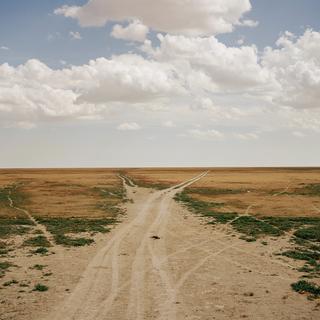


Kazakhstan's Caspian Sea is drying up, with disastrous consequences
FeatureThe Caspian Sea's water levels have dropped over the past 20 years, especially in the north, shared by Russia and Kazakhstan. The decline threatens biodiversity, and severely impacts the Kazakh fishing, transport, tourism and even hydrocarbon sectors.
With a well-trimmed mustache, a blue short-sleeved shirt, and a slender build, Amanjai Ibatulo, a 70-year-old former sports teacher, lives in a large white house on the northern coast of the Caspian Sea, in the Atyrau region of Kazakhstan. Twenty years ago, the shoreline was 2 kilometers from his home, on the outskirts of the village of Zhanbay – now, it's more than 20 kilometers away. The water lies at the end of a sandy track that crosses a steppe that is as dry as it is flat. "The climate here is difficult. We have very little rainfall and the wind blows constantly," said Ibatulo.
Nostalgic for the Soviet Union era, he fondly recalled a time when unemployment didn't exist and the sea was bountiful. What he misses most are the fishing trips he would share with friends: "From the 1980s to the 2000s, we didn't even need a boat because the fish were so plentiful. We'd take a volleyball net, walk around a bit and, after half an hour, come back with two or three sturgeon."
The sturgeon, recognizable by its streamlined silhouette, is the symbol of Zhanbay, with a statue of it standing, perched on a pedestal, in the center of the town. The locals value its flesh, using it to make fishbarmak, a variation of the Kazakh national dish beshbarmak, made with noodles, potatoes and onions, where fish replaces the usual horse or lamb meat. The largest species of sturgeon is known as the beluga (Huso huso, to use its scientific name, not to be confused with a cetacean species, also called the beluga), and it can reach up to 7 meters in length. Its caviar can fetch several thousand euros a kilo. Ibatulo proudly recalled his biggest catch: A 500-kilo beluga. Since 2014, the former teacher has not been allowed to fish for sturgeon. "The fines are very steep. We used to eat that fish all the time, we miss it," said Didar Yesmukhanov, Zhanbay's placid mayor.

A sign inside the town hall describes the village's history, founded in 1930 along with a fishing kolkhoz, which shut down in the 1990s. Due to overfishing, poaching, pollution and falling sea levels, the six sturgeon species found in the Caspian Sea are now threatened with extinction, according to the International Union for Conservation of Nature.
This decline mainly affects the northern part of the shallow inland sea, shared by Russia and Kazakhstan. It is a basin where two major rivers, the Volga and the Ural, converge, enabling sturgeon to swim upstream to spawn. In Zhanbay, the official fishing season lasts a few months, in spring and autumn, and now primarily focuses on carp. However, because of the low standard of living in the region, many continue to fish for sturgeon.
You have 81.44% of this article left to read. The rest is for subscribers only.
